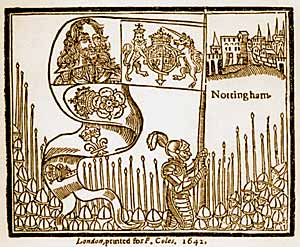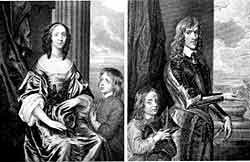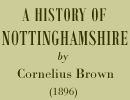< Previous | Contents | Next >

Illustration from "A true and exact Relation of the manner of his Maiesties setting up of His Standard at Nottingham, on Munday the 22. of August 1642."
The continuation of our narrative carries us on to the cloudy days of the Caroline Civil War. Our readers will be familiar with the history of the early stages of the unhappy conflict between King Charles I. and the Parliament. In August, 1634, the crisis had reached the acute stage, and his Majesty issued his proclamation for all loyal subjects to meet him at Nottingham to participate in the raising of the standard. We will not go into the controversy as to why the great Midland town was selected for this important demonstration—this throwing down the gauntlet, as it were—on the part of outraged majesty. Mr. Jacob Hooper has discussed that point at length, and the inquiring student may look up the pros and cons of that question in his quaint history at leisure.
The King was in Yorkshire, and having given his decision for Nottingham, where he purposed gathering his forces around him, he set out for his destination, passing Lincoln, Newark, and Southwell, reaching Nottingham on August 19. Next day he reviewed his cavalry, 800 strong, and, hearing that the Earl of Essex was marching upon Coventry, he hurried to obtain possession of it; but upon his arrival, the gates of Coventry were closed against him, and all he could do was to return to Nottingham to prepare for the opening act of the drama which was to have such a tragic termination.
Doubts have been entertained as to where the standard was unfurled—whether on the castle or on the adjoining hill. Mr. Bailey, the local historian, suggests that there were two standards raised: one for the military men at the castle and the other a popular streamer, for the inhabitants to rally round on what has always been known since as Standard Hill.
Clarendon gives the date as the 25th; but some local writers affirm that it was Monday, the 22nd. Probably the usual flag was hoisted when the King arrived on the 22nd, and the historic incident, more generally known as the ‘raising of the standard,’ took place, according to arrangement, on the 25th. The day after the ‘raising of the standard’ intelligence was received that the army of the rebels was at Northampton, and after a short interval active hostilities commenced. Nottingham cast in its lot with the cause of the Parliament, and the custody of the castle was entrusted to Colonel Hutchinson. No man ever had a wife who was a greater admirer of her husband’s achievements than had Colonel Hutchinson; and very few have had such a biographer as she was. The memoirs of her husband, which have now reached classic rank, tell with great minutia the details of encounters between the two rival garrisons of Nottingham on the side of the Parliament and Newark ‘for God ‘and for the King.’
The Marquis of Newcastle summoned the town to surrender; but Colonel Hutchinson informed his messenger that if his lordship would have the castle he would have to wade to it through blood. Happily, the borough escaped the threatened attack of the Marquis at that time; but the reprisals engaged in, and the sieges under which the two towns were alternately laid, make up a fascinating story for those familiar with the topography of the district.
Eventually, Charles surrendered to the Scots’ army that was besieging Newark, in May, 1646, and in the following February he passed through Nottingham in custody of the army of the Parliament.

Lucy and John Hutchinson.
The Nottingham garrison was reduced; Colonel Hutchinson retired to the village of Owthorpe, and the castle was dismantled, at which Cromwell, when he came this way from the North, was ‘heartily vexed,’ remonstrating with Colonel Hutchinson for having been the cause of its abandonment. It remained in ruins till the Restoration, when it was claimed by the Duke of Buckingham in right of his mother, heiress of the Earl of Rutland. His Grace disposed of it to the Duke of Newcastle, and with his descendants the proprietorship still remains.
On his memorable march to London General Monk passed through Nottingham, and was cordially received. This was in January, 1660, when the snow lay so deep in the roads as to render them almost impassable. Like most other places, Nottingham had grown tired of the Commonwealth, and was yearning for a restoration of monarchial rule. Mrs. Hutchinson says: ‘The town, as almost all the rest of the island, began to be amazed, and declare themselves so in the desire of the King. The boys, set on by their fathers and masters, got drums and colours, and marched up and down the town, and trained themselves in a military position, and offered many affronts to the soldiers of the army who were quartered there, which were two troops of Colonel Hacker’s regiment; insomuch that one night there were about 40 of the soldiers hurt and wounded with stones upon the occasion of taking the drums when the youths were gathering together to make bonfires to burn the rump, as was the custom of these mad days. The soldiers, provoked to rage, shot again, and killed in the scuffle two Presbyterians; one was an elder and an old professor, and one that had been a great zealot for the cause, and master of the magazine at Nottingham Castle.’ In the entry of burials at St. Mary’s Church during February is the following: ‘Mr. Richard Hawkins, an elder, who was slain by the soldiers in the late tumult, standing at his own door.’
In May, 1660, the longing for kingly rule culminated in the return of Charles II., and the rejoicings throughout the country were on a scale of unexpected magnitude. Even Mrs. Hutchinson frankly confesses that ‘his Majesty was received with a universal joy and triumph even to his own amazement,’ but says nothing as to what took place in Nottingham at the time. There was a curious pamphlet, however, in Mr. John Camden Hotten’s collection, entitled ‘Charles II. proclaimed with Joy at Nottingham, 1660 ‘—a rudely-printed paper of sixteen pages, in which it was recorded that the Mayor of Nottingham acted like a madman at the celebrations. ‘His worship got one half of the people to fire off guns, while another half walked about singing psalms.’ Notices of the burning of Milton’s book are given; and Cromwell’s effigy was exhibited with a rope around its neck. Another pamphlet in the same collection was entitled, ‘A Speech made at Nottingham, April 2nd, 1660, at the Election of Arthur Stanhope, esquire, and Colonel John Hutchinson, then burgesses, to serve in the next Parliament.’ Colonel Hutchinson was eventually discharged the House, and being taken into custody, was imprisoned at Sandown Castle, where he died September 11, 1664.
The reaction which had set in so strongly continued to manifest itself in various ways. Not only were many of those punished who had taken a prominent part in maintaining the Parliamentary cause in this county, but the current of popular opinion flowed with great force against the Nonconforming party. In 1665 the notorious Five Mile Act was passed, and in compliance with the wishes of Parliament an order was issued for inquiry as to all ‘conventicles or unlawful meetings under pretence of religion.’ Quakers and Anabaptists were the sects against whom the strongest feelings of animosity were shown, but reports were sent from each parish stating where the Dissenters met, and what they did at their meetings. The reports from many of the villages of Notts are printed in Bailey’s Annals, and it appears therefrom that, in spite of their persecutions, the Quakers were a tolerably numerous body, their meetings at Ruddington, for instance, being attended by forty or fifty people. Several curious pamphlets, hitherto unnoticed by our local historians, were issued, giving an account of their sufferings. One was ‘The Lambs’ Defence against Lies a true testimony concerning the sufferings and death of James Parnell, of Redford, Notts.’ Parnell was imprisoned at Colchester, chained to a bar of wood, and taken eighteen miles through the country ‘as a sport, or gazing stock.’ Finally, they put him in a high hole in a wall, from which he accidentally fell, receiving injuries which terminated in his death. Another pamphlet tells us of the sufferings of James Jackson, ‘formerly a parish priest, of Nottingham, now a despised follower of the Lamb—in scorn, called a Quaker;’ and a third gives a hundred instances of persecution in various localities in Notts. No less a personage than Dr. Thoroton, the historian, and a justice of the peace, was one of the most virulent of the persecutors, and even Penis-ton Whalley, a relative of Colonel Whalley, the stanch Parliamentarian warrior, in charging the grand jury at the Newark Quarter Sessions on July 21, 1673, delivers a tirade against ‘Buzzardly Quakers,’ and criticises in strong terms the Independents and Romanists.
But if Nottingham went almost mad in its devotion to Charles II. on his return, it was one of the first to declare against James II. The Earl of Devonshire, Lord Howe, Lord Delamere, and others, appeared at the Malt Cross and declared against the arbitrary measures of his Majesty, whereupon the town became the headquarters of the Northern insurrection, and was enthusiastic in the movement that placed William III. on the throne of England.
